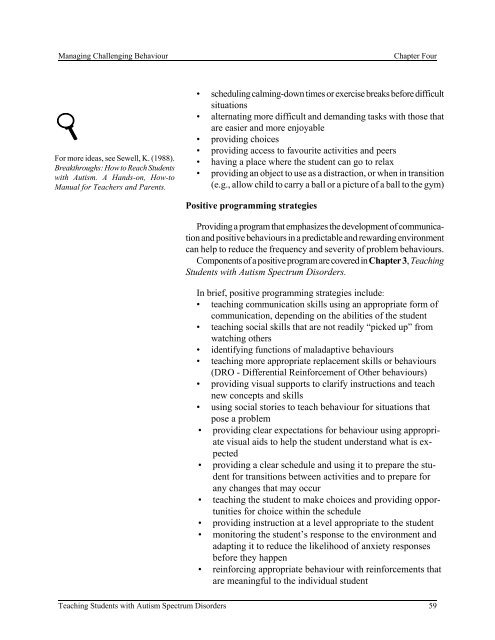Teaching Students with Autism Spectrum Disorders
Teaching Students with Autism Spectrum Disorders
Teaching Students with Autism Spectrum Disorders
Create successful ePaper yourself
Turn your PDF publications into a flip-book with our unique Google optimized e-Paper software.
Managing Challenging Behaviour Chapter Four<br />
For more ideas, see Sewell, K. (1988).<br />
Breakthroughs: How to Reach <strong>Students</strong><br />
<strong>with</strong> <strong>Autism</strong>. A Hands-on, How-to<br />
Manual for Teachers and Parents.<br />
• scheduling calming-down times or exercise breaks before difficult<br />
situations<br />
• alternating more difficult and demanding tasks <strong>with</strong> those that<br />
are easier and more enjoyable<br />
• providing choices<br />
• providing access to favourite activities and peers<br />
• having a place where the student can go to relax<br />
• providing an object to use as a distraction, or when in transition<br />
(e.g., allow child to carry a ball or a picture of a ball to the gym)<br />
Positive programming strategies<br />
Providing a program that emphasizes the development of communication<br />
and positive behaviours in a predictable and rewarding environment<br />
can help to reduce the frequency and severity of problem behaviours.<br />
Components of a positive program are covered in Chapter 3, <strong>Teaching</strong><br />
<strong>Students</strong> <strong>with</strong> <strong>Autism</strong> <strong>Spectrum</strong> <strong>Disorders</strong>.<br />
In brief, positive programming strategies include:<br />
• teaching communication skills using an appropriate form of<br />
communication, depending on the abilities of the student<br />
• teaching social skills that are not readily “picked up” from<br />
watching others<br />
• identifying functions of maladaptive behaviours<br />
• teaching more appropriate replacement skills or behaviours<br />
(DRO - Differential Reinforcement of Other behaviours)<br />
• providing visual supports to clarify instructions and teach<br />
new concepts and skills<br />
• using social stories to teach behaviour for situations that<br />
pose a problem<br />
• providing clear expectations for behaviour using appropriate<br />
visual aids to help the student understand what is expected<br />
• providing a clear schedule and using it to prepare the student<br />
for transitions between activities and to prepare for<br />
any changes that may occur<br />
• teaching the student to make choices and providing opportunities<br />
for choice <strong>with</strong>in the schedule<br />
• providing instruction at a level appropriate to the student<br />
• monitoring the student’s response to the environment and<br />
adapting it to reduce the likelihood of anxiety responses<br />
before they happen<br />
• reinforcing appropriate behaviour <strong>with</strong> reinforcements that<br />
are meaningful to the individual student<br />
<strong>Teaching</strong> <strong>Students</strong> <strong>with</strong> <strong>Autism</strong> <strong>Spectrum</strong> <strong>Disorders</strong> 59

















